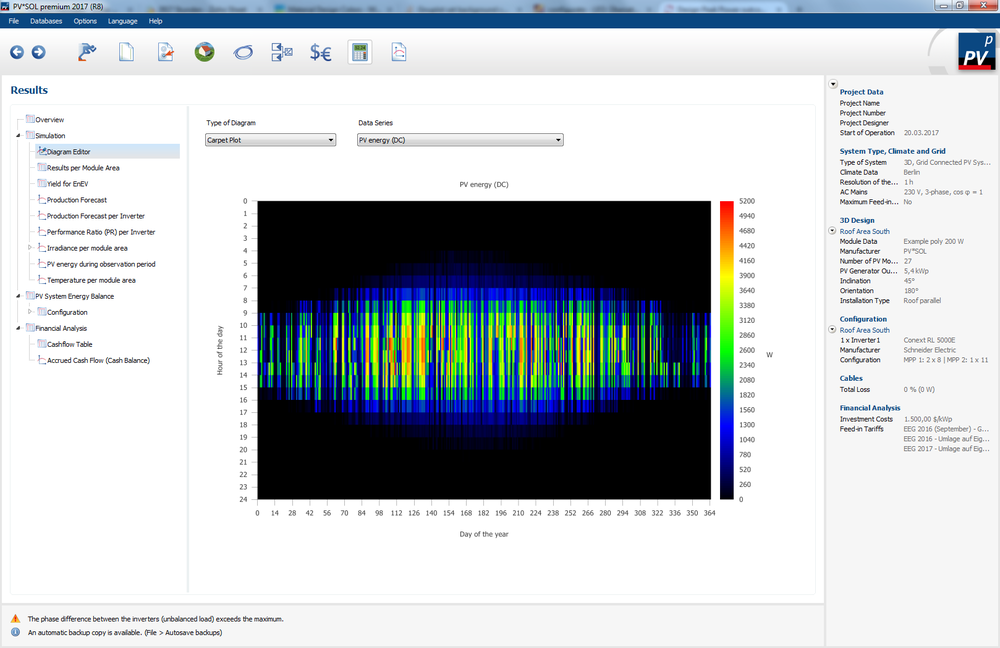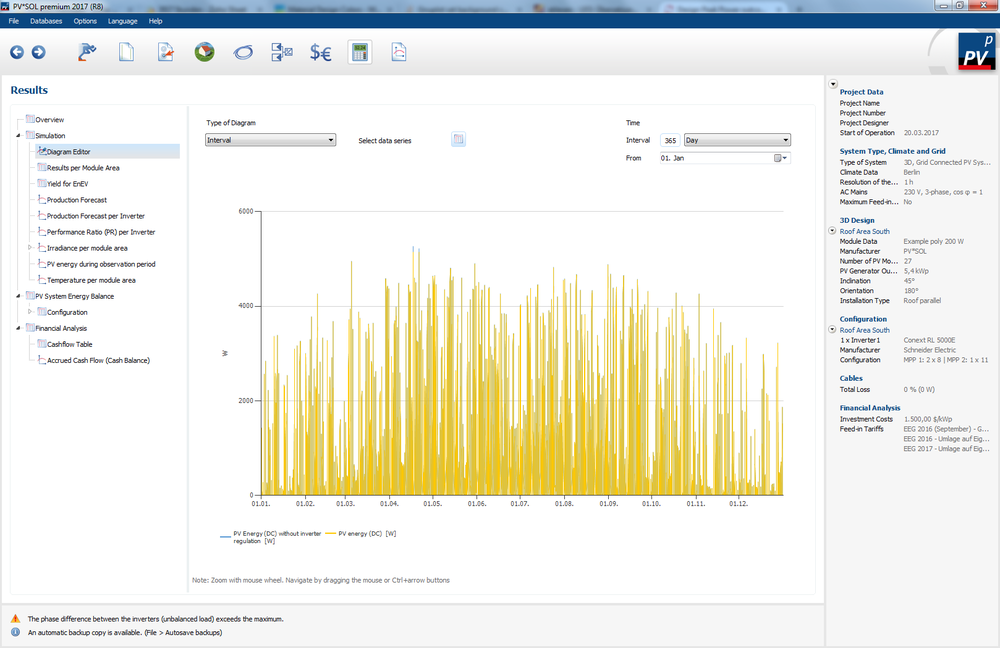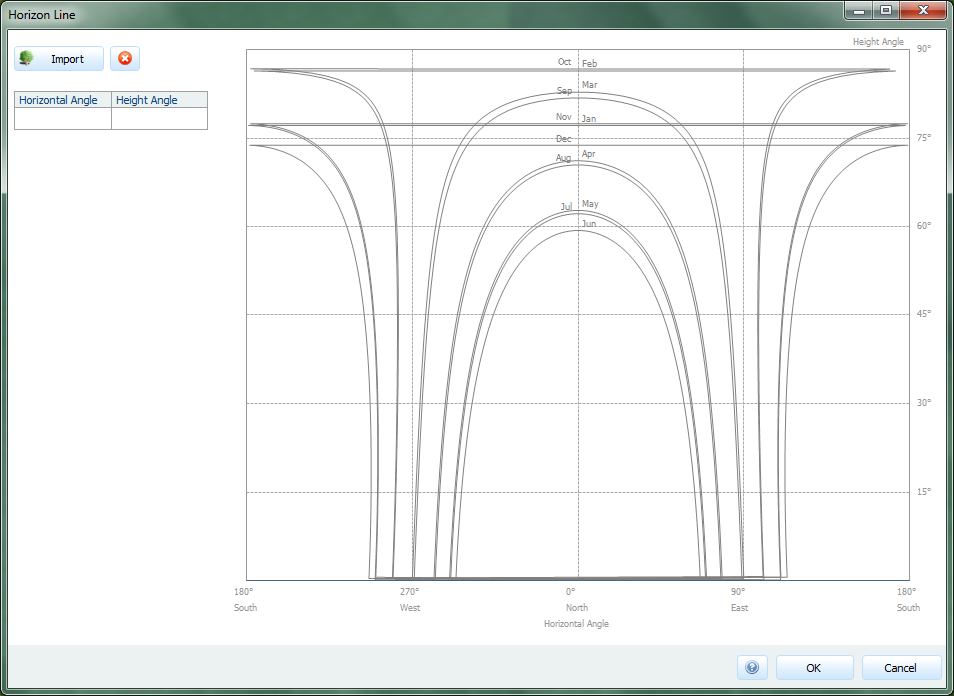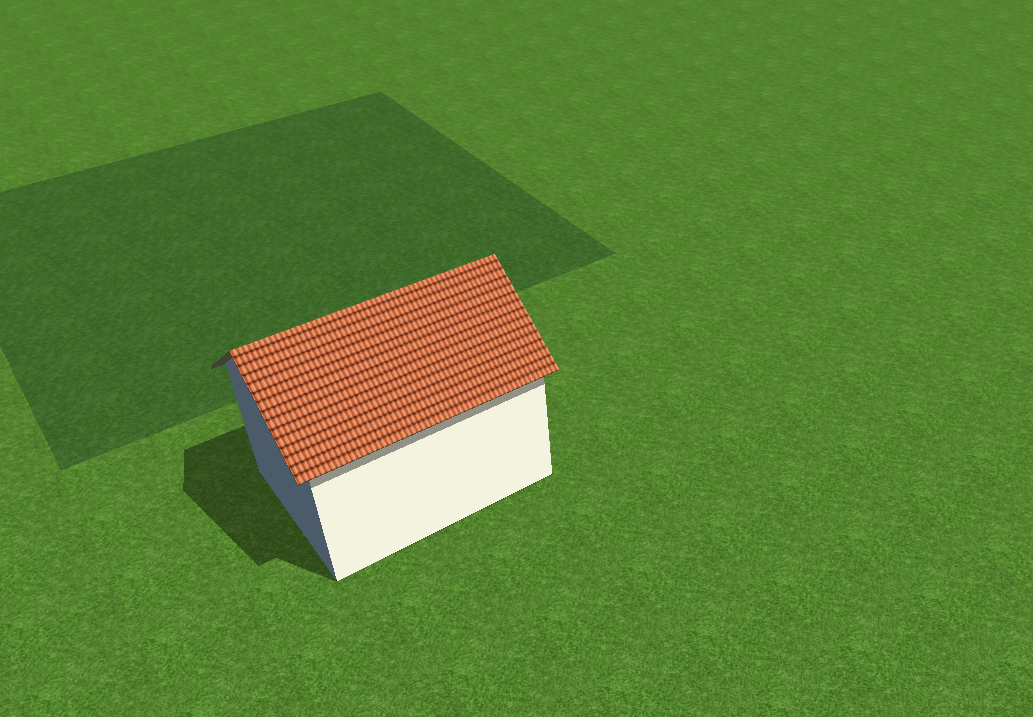-
Posts
1,855 -
Joined
-
Last visited
-
Days Won
173
Everything posted by developer_mh
-

first steps [Tutorial] PV*SOL premium 2017– First Steps
developer_mh posted a question in Tutorials (Read only)
[Tutorial] PV*SOL premium 2017 - First Steps -
Hi Eng.Najeva, could you explain a bit more in detail what is not working? Is there an error message that you could share? Thanks in advance, kind regards, Martin
-
Hi Daniel, edit: Please see the next post for updated information thanks for your question. You are right, at the moment we handle the MPPT functionality and the DC/AC conversion at the same time, i.e. the SolarEdge devices are represented as normal, if small, PV inverters in our simulations. Energetically the results won't be that different in the end compared to using separate devices for MPPT and DC/AC, but yes, in the circuits and plans (and in the details of the energy balance), these systems are simplified right now. For the next major version we are working on implementing a totally new approach for power electronics and polymorphic strings, where we will cover this topic as well. Then you will be able to connect each module to a power optimizer (or two modules to one power optimizer) and connect these to a common inverter. The major version is scheduled for autumn this year. Kind regards, Martin
-
Hi Daniel, there are several ways to determine the maximum DC power of the PV system. Personally I think the fatest way is to go to the 'Diagram Editor' on the results page, select carpet plot and choose 'PV energy (DC)' data series. The maximum value can be easily read off the scale on the right. See the picture below: Alternatively, you can go to the interval mode of the diagram editor, choose the corresponding data sets and plot the whole year: When you hover over these diagrams with your mouse, you'll see the actual value in Watts. The third option would be to export the simulation results as a csv file, open it in Excel and search for the maximum over the respective columns. Hope that helps, kind regards, Martin
-
Sehr merkwürdig... hast du mal probiert, die Regionaleinstellungen von Windows zu verändern, nicht nur das Tastaturlayout? Aber eigentlich kann es daran nicht liegen, da wir ja auch andere Kunden in Belgien haben, bei denen das Problem nicht auftritt. Bin etwas ratlos, aber probieren würde ich einfach mal: Regionaleinstellungen auf Deutsch (Deutschland), PVSOL deinstallieren und wieder neu installieren nochmal in 3D prüfen Mehr fällt mir grade nicht ein. Wenn das nichts hilft, wäre es sehr hilfreich, wenn du mal einen kurzen Screencast machen könntest, der das Problem zeigt. Auch die Systeminfos wären dann interessant. Viel Erfolg, hoffentlich klappts! Martin
-
Hallo Daniel, das ist ungewöhnlich und sollte so nicht sein, mit der Testversion hat das auch nichts zu tun. Bisher ist uns auch noch nicht zu Ohren gekommen, dass andere User das Problem hatten. Passiert das ständig bei egal welchen Zahlen oder nur sporadisch, evtl bei bestimmten Zahlen, evtl. mit Komma oder Punkt? Beste Grüße, Martin
-
Es müsste per privater Nachricht gehen. Wenn Sie mit der Maus auf meinen Namen gehen (nicht klicken), erscheint eine Ansicht, in der ganz unten "Message" steht. Damit sollte es gehen.
-
Hallo sonnenblume, wäre es möglich, das Bild zu sehen, das in Photoplan geladen wurde? Sonst ist es schwer zu sagen, was genau da passiert ist. Viele Grüße, Martin
-

Question about simulation settings for shadow
developer_mh replied to Johan van t Wout's topic in PV*SOL
Hey, for those purposes you could have a look at the horizon editor. There you'll see the sun paths for the 21st of every month on the location you selected. Here is a screenshot for Surabaya, Indonesia: Hope that helps, Martin -
Hi Johan, you just need to drag the object off the button 'Building'. I tried to make a short gif to demonstrate: Hope that helps, Martin
-
Hi Johan, thanks for your question! You can just drag the orphan module next to your string. In fact, you can drag it anywhere you want. When you begin dragging, a colored frame will appear that you can move over a module of another string. In your case you might want to place it above 7.1.3.14 and left to 7.1.3.1, right? When you drop it there, it will be switched with the module that was there before. Hope that helps, kind regards, Martin
-
Dear Johan, This feature was added in version 2016 R1, so I am afraid that is not possible with your version of 7.5.4. Here you can see the full log of changes and new features that were added since version 7.5.4 (a lot, really ): http://www.valentin-software.com/en/support-service/customer-service/release-notes/pvsol-premium You could download the newest version (2017 R8), test it, and perhaps you might consider upgrading - or just go for a software maintenance which automatically provides you with all the updates. Kind regards, Martin
-
Hallo! Der Vollständigkeit halber: In PV*SOL ist es seit der Version 2017 R1 (veröffentlicht im Oktober 2016) möglich, DC gekoppelte Speichersysteme zu simulieren. Dabei stehen Generator- und Zwischenkreis-Kopplungen zur Verfügung. Hier dazu mehr: https://help.valentin-software.com/pvsol/2018/berechnungsgrundlagen/batteriesysteme/ Beste Grüße, Martin
-
Hi, we now also have a short tutorial video on youtube that shows how to connect two module areas to one MPP tracker: Cheers, Martin
-
Hi, just for the sake of being up-to-date: We have P90 exceedence probability calculations in PV*SOL since version 2017 R1 (released in October 2016). More information here: https://help.valentin-software.com/pvsol/2019/pages/financial-analysis/bankability-p50p90/ Regards, Martin
-

Lastprofil Wärmepumpenanlage mit Heizung und Trinkwasser (Luft/Wasser)
developer_mh replied to danielsun's topic in PV*SOL
Hallo Daniel, danke für die Anfrage zu den Lastprofilen der Wärmepumpen. Ich habe das eben versucht nachzuvollziehen, aber bei mir bekommen ich auch im csv-Export die zu erwartenden 3441 kWh heraus. Vielleicht prüfst du nochmal die folgenden Punkte Bist du beim Bilden der Summe im csv-Export vielleicht in der Spalte verrutscht? Stehen vorne auf der Seite "Verbraucher" auch wirklich die 3441 kWh als jährlicher Gesamtverbrauch? Ich hoffe, das hilft weiter. Wenn nicht, immer gerne fragen Beste Grüße und einen guten Wochenstart, Martin ps: ich verschiede den Eintrag mal ins deutsche Forum, ok?- 1 reply
-
- lastprofil
- wärmepumpe
-
(and 1 more)
Tagged with:
-

[Tutorial] PV*SOL premium 2017– Mounting system on a facade
developer_mh posted a question in Tutorials (Read only)
[Tutorial] PV*SOL premium 2017– Mounting system on a facade How to create a mounting system on a facade: In the 3D environment, go to the page "Module Mounting" Move to the facade before defining the assembly system Click the button "New Assembly System" Select "Facade Tilt" For a module inclination of 30°, the assembly system must have a mount angle of 60° to the facade A 75° mount angle results in an inclination of 15° to the horizontal plane Press the enter key to confirm or click "OK" Click the button "Fill Area" Now click and hold the left mouse button to create a module row in the defined area Thanks for watching!-
- mounting system
- assembly system
- (and 8 more)
-
[Tutorial] PV*SOL premium 2017– Aufständerung an einer Fassade So erstellen Sie eine Aufständerung an einer Fassade Gehen Sie auf die Seite "Modulaufständerung" Wechseln Sie vor der Definition des Montagesystems auf die Fassade Klicken Sie den Button "Neues Montagesystem" Wählen Sie "Fassadenaufständerung" Für eine Modulneigung von 30° muss das Montagesystem einen Aufständerungswinkel von 60° zur Fassade haben 75° Aufständerungswinkel ergibt eine Neigung von 15° zur Horizontalen Bestätigen Sie mit der Eingabetaste oder klicken Sie "OK" Klicken Sie den Button "Aufziehen" Klicken Sie nun links und halten Sie die Maustaste gedrückt, um im definierten Bereich eine Modulreihe zu erzeugen Vielen Dank fürs Zuschauen!
-
[Tutorial] PVSOL premium 2017 - Configure two dormers to one string How to configure two dormers (module areas) to one string In the 3D environment, go to the page "Module configuration" Click on the button with the hand symbol to open the window "Define Module Areas" Now click on the import button to import all module arrays Combine the groups by clicking the button "Combine Selection". Make sure that the groups are checked Click the "Configure" button Use the "Suggest Configuration" feature to select a suitable inverter Now both dormers are combined in a single string Thanks for watching!
-
- configuration
- two dormers
-
(and 5 more)
Tagged with:
-
Hi Allan, I'm afraid this is not possible at the moment, but we will put it on our todo list. Kind regards, Martin
-
PV*SOL premium 2017– Zwei Gauben an einen Strang verschalten So verschalten Sie zwei Gauben (Modulflächen) an einen Strang: Gehen Sie auf die Seite "Modulverschaltung" Klicken Sie den Button mit dem Hand-Symbol, um das Fenster "Modulflächen definieren" zu öffnen Klicken Sie jetzt den "Importieren" Button , um alle Modulformationen zu importieren Vereinigen Sie die Gruppen, indem Sie den Button "Auswahl vereinigen" klicken. Achten Sie darauf, dass beide Gruppen ausgewählt sind (Häkchen) Klicken Sie auf den "Verschalten" Button Nun sind beide Gauben an einem Strang verschaltet. Vielen Dank fürs Zuschauen!
-
- mpp
- wechselrichter
-
(and 4 more)
Tagged with:
-
Dear allan, for mounting systems it is not yet possible to create the cable plan in 3D. However, if you plan your mounting system in 3D and go back to 2D, you can enter your cable lengths and other details on the page "Cables" when you select the detailed option. In the info dialog at the bottom of the page you'll find a summary of all cables and other components. Hope that helps, let me know if you need any other assistance. Kind regards, Martin
-
Hallo Gerald, wäre es möglich, das Projekt zu sehen? Gerne per PN an mich oder hier posten (nachdem sensible Daten entfernt wurden). Ohne das Projekt ist es leider schwer, etwas dazu zu sagen.. und ich verschiebe die Frage mal ins deutsche Forum, ok? Beste Grüße, Martin
-
Dear sunlightfuture, Thank you for your suggestions! We will take both ideas on our list for the next release planning. Right now we are not working on fine tuning the battery cahrge/discharge scheduling mechanisms, but I think that your ideas make perfectly sense and we should consider them for the future. So, what you would need is an option to restrict the battery discharge to a specific period of time an option to restrict the grid charge to a specific period of time Is that correct? Or would you need other/more options? Kind regards, Martin
-
Hallo BeckerF, vielen Dank für die Anmerkung und Entschuldigung für die etwas späte Antwort. Bei der Erstellung der Lastprofile für die Wärmepumpen haben wir uns bemüht, möglichst allgemeingültige Annahmen zu treffen, damit die Profile auf breiter Basis anwendbar sind. Uns ist jedoch bewusst, dass diese Profile nicht auf jeden Anwendungsfall zutreffen. Aber Sie haben Recht, eine Einschätzung, ob das gewählt Lastprofil den eigenen Anforderungen entspricht, fällt leichter, wenn man grundätzliche Angaben zu den Profilen hat. Wir werden die Infos in einer der nächsten Versionen in den Kommentaren mit ausliefern. Hier schon mal die Daten: Über den Jahresenergiebedarf können Sie dann die Pastprofile grob skalieren, um sie an Ihren Bedarf anzupassen. Ich hoffe, das hilft erstmal weiter. Beste Grüße, Martin






